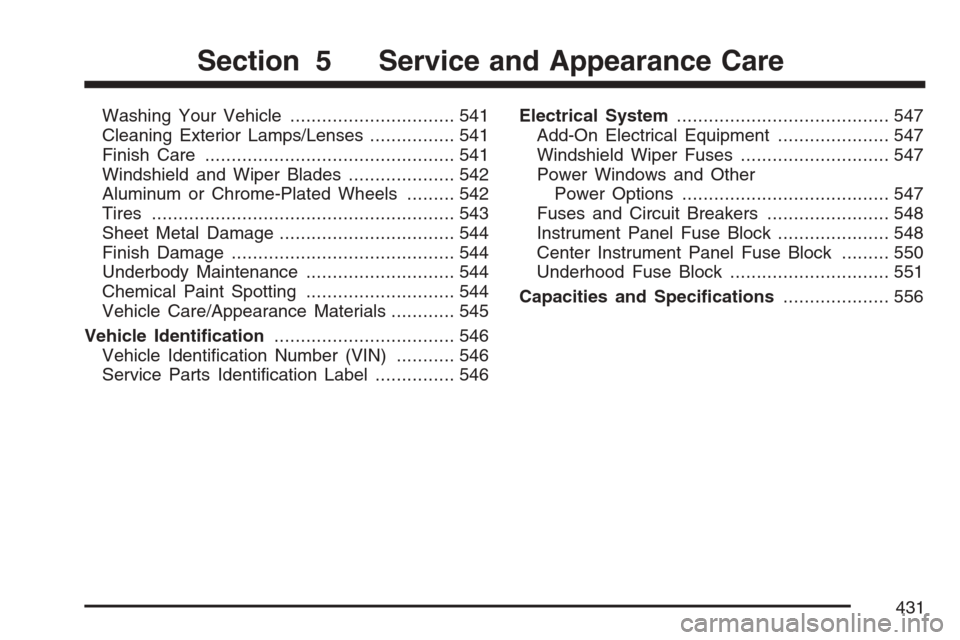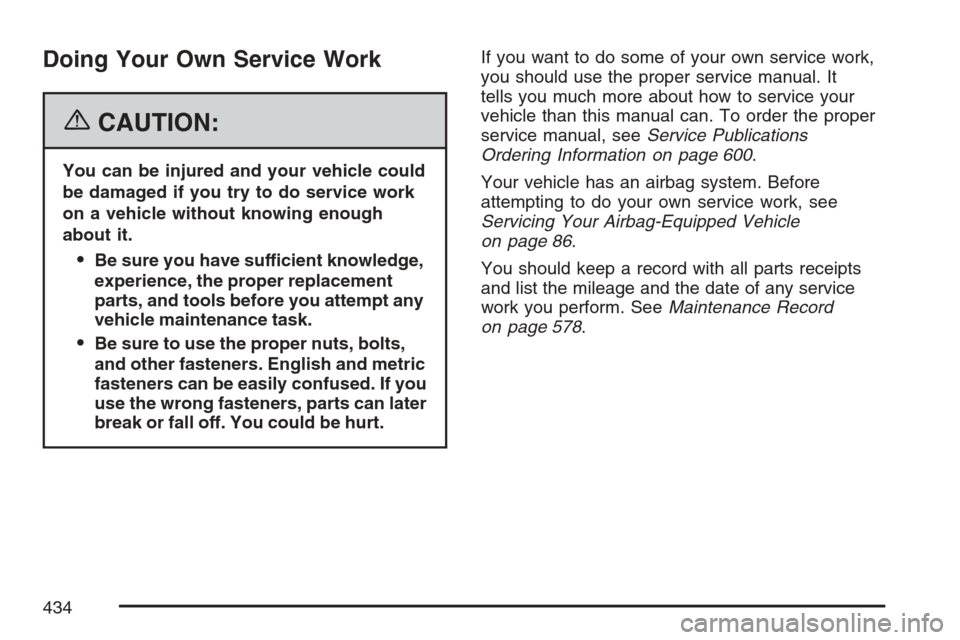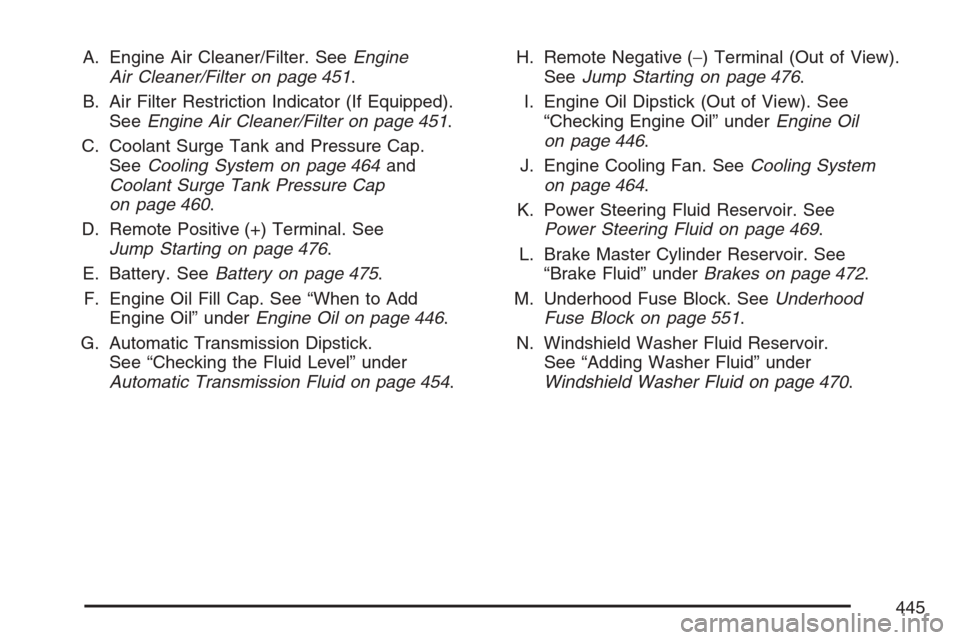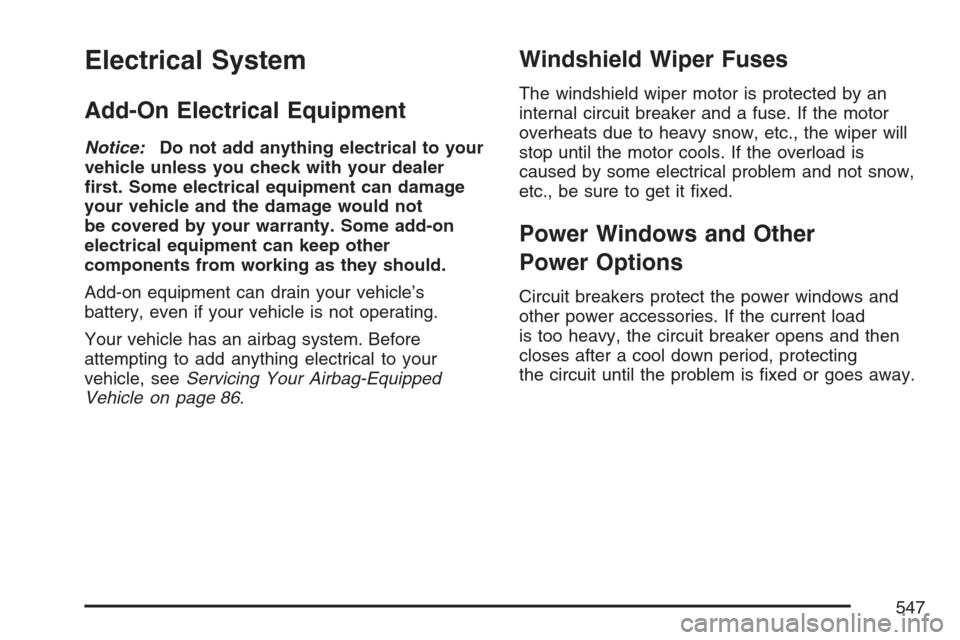Page 431 of 618

Washing Your Vehicle............................... 541
Cleaning Exterior Lamps/Lenses................ 541
Finish Care............................................... 541
Windshield and Wiper Blades.................... 542
Aluminum or Chrome-Plated Wheels......... 542
Tires......................................................... 543
Sheet Metal Damage................................. 544
Finish Damage.......................................... 544
Underbody Maintenance............................ 544
Chemical Paint Spotting............................ 544
Vehicle Care/Appearance Materials............ 545
Vehicle Identi�cation.................................. 546
Vehicle Identi�cation Number (VIN)........... 546
Service Parts Identi�cation Label............... 546Electrical System........................................ 547
Add-On Electrical Equipment..................... 547
Windshield Wiper Fuses............................ 547
Power Windows and Other
Power Options....................................... 547
Fuses and Circuit Breakers....................... 548
Instrument Panel Fuse Block..................... 548
Center Instrument Panel Fuse Block......... 550
Underhood Fuse Block.............................. 551
Capacities and Speci�cations.................... 556
Section 5 Service and Appearance Care
431
Page 434 of 618

Doing Your Own Service Work
{CAUTION:
You can be injured and your vehicle could
be damaged if you try to do service work
on a vehicle without knowing enough
about it.
Be sure you have sufficient knowledge,
experience, the proper replacement
parts, and tools before you attempt any
vehicle maintenance task.
Be sure to use the proper nuts, bolts,
and other fasteners. English and metric
fasteners can be easily confused. If you
use the wrong fasteners, parts can later
break or fall off. You could be hurt.If you want to do some of your own service work,
you should use the proper service manual. It
tells you much more about how to service your
vehicle than this manual can. To order the proper
service manual, seeService Publications
Ordering Information on page 600.
Your vehicle has an airbag system. Before
attempting to do your own service work, see
Servicing Your Airbag-Equipped Vehicle
on page 86.
You should keep a record with all parts receipts
and list the mileage and the date of any service
work you perform. SeeMaintenance Record
on page 578.
434
Page 445 of 618

A. Engine Air Cleaner/Filter. SeeEngine
Air Cleaner/Filter on page 451.
B. Air Filter Restriction Indicator (If Equipped).
SeeEngine Air Cleaner/Filter on page 451.
C. Coolant Surge Tank and Pressure Cap.
SeeCooling System on page 464and
Coolant Surge Tank Pressure Cap
on page 460.
D. Remote Positive (+) Terminal. See
Jump Starting on page 476.
E. Battery. SeeBattery on page 475.
F. Engine Oil Fill Cap. See “When to Add
Engine Oil” underEngine Oil on page 446.
G. Automatic Transmission Dipstick.
See “Checking the Fluid Level” under
Automatic Transmission Fluid on page 454.H. Remote Negative (−) Terminal (Out of View).
SeeJump Starting on page 476.
I. Engine Oil Dipstick (Out of View). See
“Checking Engine Oil” underEngine Oil
on page 446.
J. Engine Cooling Fan. SeeCooling System
on page 464.
K. Power Steering Fluid Reservoir. See
Power Steering Fluid on page 469.
L. Brake Master Cylinder Reservoir. See
“Brake Fluid” underBrakes on page 472.
M. Underhood Fuse Block. SeeUnderhood
Fuse Block on page 551.
N. Windshield Washer Fluid Reservoir.
See “Adding Washer Fluid” under
Windshield Washer Fluid on page 470.
445
Page 547 of 618

Electrical System
Add-On Electrical Equipment
Notice:Do not add anything electrical to your
vehicle unless you check with your dealer
�rst. Some electrical equipment can damage
your vehicle and the damage would not
be covered by your warranty. Some add-on
electrical equipment can keep other
components from working as they should.
Add-on equipment can drain your vehicle’s
battery, even if your vehicle is not operating.
Your vehicle has an airbag system. Before
attempting to add anything electrical to your
vehicle, seeServicing Your Airbag-Equipped
Vehicle on page 86.
Windshield Wiper Fuses
The windshield wiper motor is protected by an
internal circuit breaker and a fuse. If the motor
overheats due to heavy snow, etc., the wiper will
stop until the motor cools. If the overload is
caused by some electrical problem and not snow,
etc., be sure to get it �xed.
Power Windows and Other
Power Options
Circuit breakers protect the power windows and
other power accessories. If the current load
is too heavy, the circuit breaker opens and then
closes after a cool down period, protecting
the circuit until the problem is �xed or goes away.
547
Page 548 of 618
Fuses and Circuit Breakers
The wiring circuits in your vehicle are protected
from short circuits by a combination of fuses,
circuit breakers and fusible thermal links.
This greatly reduces the chance of �res caused by
electrical problems.
Look at the silver-colored band inside the fuse.
If the band is broken or melted, replace the fuse.
Be sure you replace a bad fuse with a new
one of the identical size and rating.
If you ever have a problem on the road and don’t
have a spare fuse, you can borrow one that has the
same amperage. Just pick some feature of your
vehicle that you can get along without — like
the radio or cigarette lighter — and use its fuse,
if it is the correct amperage. Replace it as soon
as you can.
Instrument Panel Fuse Block
The instrument panel fuse block access door
is located on the driver’s side edge of the
instrument panel.
Fuses Usage
LT DRDriver’s Side Power Window
Circuit Breaker
REAR SEAT Rear Seats
548
Page 549 of 618
Fuses Usage
AUX PWR2 Rear Cargo Area Power Outlets
SWC BKLT Steering Wheel Controls Backlight
DDM Driver Door Module
CTSYDome Lamps, Driver’s Side
Turn Signal
LT STOP TRN Driver’s Side Turn Signal, Stoplamp
DIM Instrument Panel Back Lighting
RT STOP TRNPassenger’s Side Turn Signal,
Stoplamp
BCM Body Control Module
UNLCK2 Power Door Lock 2 (Unlock Feature)
LCK2 Power Door Lock 2 (Lock Feature)
STOP LAMPSStoplamps, Center-High
Mounted Stoplamp
REAR HVAC Rear Climate Controls
PDMPassenger Door Module,
Universal Home Remote SystemFuses Usage
AUX PWR Accessory Power Outlets
IS LPS Interior Lamps
UNLCK1 Power Door Lock 1 (Unlock Feature)
OBS DETUltrasonic Rear Parking Assist,
Power Liftgate
LCK1 Power Door Lock 1 (Lock Feature)
REAR WPR Rear Wiper
COOLED
SEATSNot Used
DSMDriver Seat Module,
Remote Keyless Entry System
Harness
ConnectorUsage
LT DR Driver’s Door Harness Connection
BODY Harness Connector
BODY Harness Connector
549
Page 550 of 618
Center Instrument Panel Fuse Block
The center instrument panel fuse block is located
underneath the instrument panel, to the left of the
steering column.
Top View
Harness
ConnectorUsage
BODY 2 Body Harness Connector 2
BODY 1 Body Harness Connector 1
BODY 3 Body Harness Connector 3
HEADLINER 3 Headliner Harness Connector 3
HEADLINER 2 Headliner Harness Connector 2
HEADLINER 1 Headliner Harness Connector 1
BRAKE
CLUTCHBrake Clutch Harness Connector
SEO/UPFITTERSpecial Equipment Option
Up�tter Harness Connector
550
Page 551 of 618
Circuit
BreakerUsage
CB1Passenger’s Side Power Window
Circuit Breaker
CB2 Passenger’s Seat Circuit Breaker
CB3 Driver’s Seat Circuit Breaker
CB4 Not UsedUnderhood Fuse Block
The underhood fuse block is located in the engine
compartment, on the driver’s side of the vehicle.
Lift the cover for access to the fuse/relay block.
551